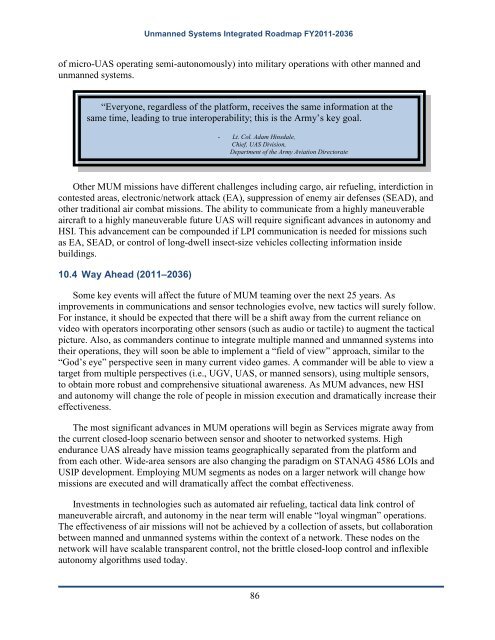Unmanned Systems Integrated Roadmap FY2011-2036 - Defense ...
Unmanned Systems Integrated Roadmap FY2011-2036 - Defense ...
Unmanned Systems Integrated Roadmap FY2011-2036 - Defense ...
You also want an ePaper? Increase the reach of your titles
YUMPU automatically turns print PDFs into web optimized ePapers that Google loves.
<strong>Unmanned</strong> <strong>Systems</strong> <strong>Integrated</strong> <strong>Roadmap</strong> <strong>FY2011</strong>-<strong>2036</strong><br />
of micro-UAS operating semi-autonomously) into military operations with other manned and<br />
unmanned systems.<br />
“Everyone, regardless of the platform, receives the same information at the<br />
same time, leading to true interoperability; this is the Army’s key goal.<br />
Other MUM missions have different challenges including cargo, air refueling, interdiction in<br />
contested areas, electronic/network attack (EA), suppression of enemy air defenses (SEAD), and<br />
other traditional air combat missions. The ability to communicate from a highly maneuverable<br />
aircraft to a highly maneuverable future UAS will require significant advances in autonomy and<br />
HSI. This advancement can be compounded if LPI communication is needed for missions such<br />
as EA, SEAD, or control of long-dwell insect-size vehicles collecting information inside<br />
buildings.<br />
10.4 Way Ahead (2011–<strong>2036</strong>)<br />
- Lt. Col. Adam Hinsdale,<br />
Chief, UAS Division,<br />
Department of the Army Aviation Directorate<br />
Some key events will affect the future of MUM teaming over the next 25 years. As<br />
improvements in communications and sensor technologies evolve, new tactics will surely follow.<br />
For instance, it should be expected that there will be a shift away from the current reliance on<br />
video with operators incorporating other sensors (such as audio or tactile) to augment the tactical<br />
picture. Also, as commanders continue to integrate multiple manned and unmanned systems into<br />
their operations, they will soon be able to implement a “field of view” approach, similar to the<br />
“God’s eye” perspective seen in many current video games. A commander will be able to view a<br />
target from multiple perspectives (i.e., UGV, UAS, or manned sensors), using multiple sensors,<br />
to obtain more robust and comprehensive situational awareness. As MUM advances, new HSI<br />
and autonomy will change the role of people in mission execution and dramatically increase their<br />
effectiveness.<br />
The most significant advances in MUM operations will begin as Services migrate away from<br />
the current closed-loop scenario between sensor and shooter to networked systems. High<br />
endurance UAS already have mission teams geographically separated from the platform and<br />
from each other. Wide-area sensors are also changing the paradigm on STANAG 4586 LOIs and<br />
USIP development. Employing MUM segments as nodes on a larger network will change how<br />
missions are executed and will dramatically affect the combat effectiveness.<br />
Investments in technologies such as automated air refueling, tactical data link control of<br />
maneuverable aircraft, and autonomy in the near term will enable “loyal wingman” operations.<br />
The effectiveness of air missions will not be achieved by a collection of assets, but collaboration<br />
between manned and unmanned systems within the context of a network. These nodes on the<br />
network will have scalable transparent control, not the brittle closed-loop control and inflexible<br />
autonomy algorithms used today.<br />
86

















